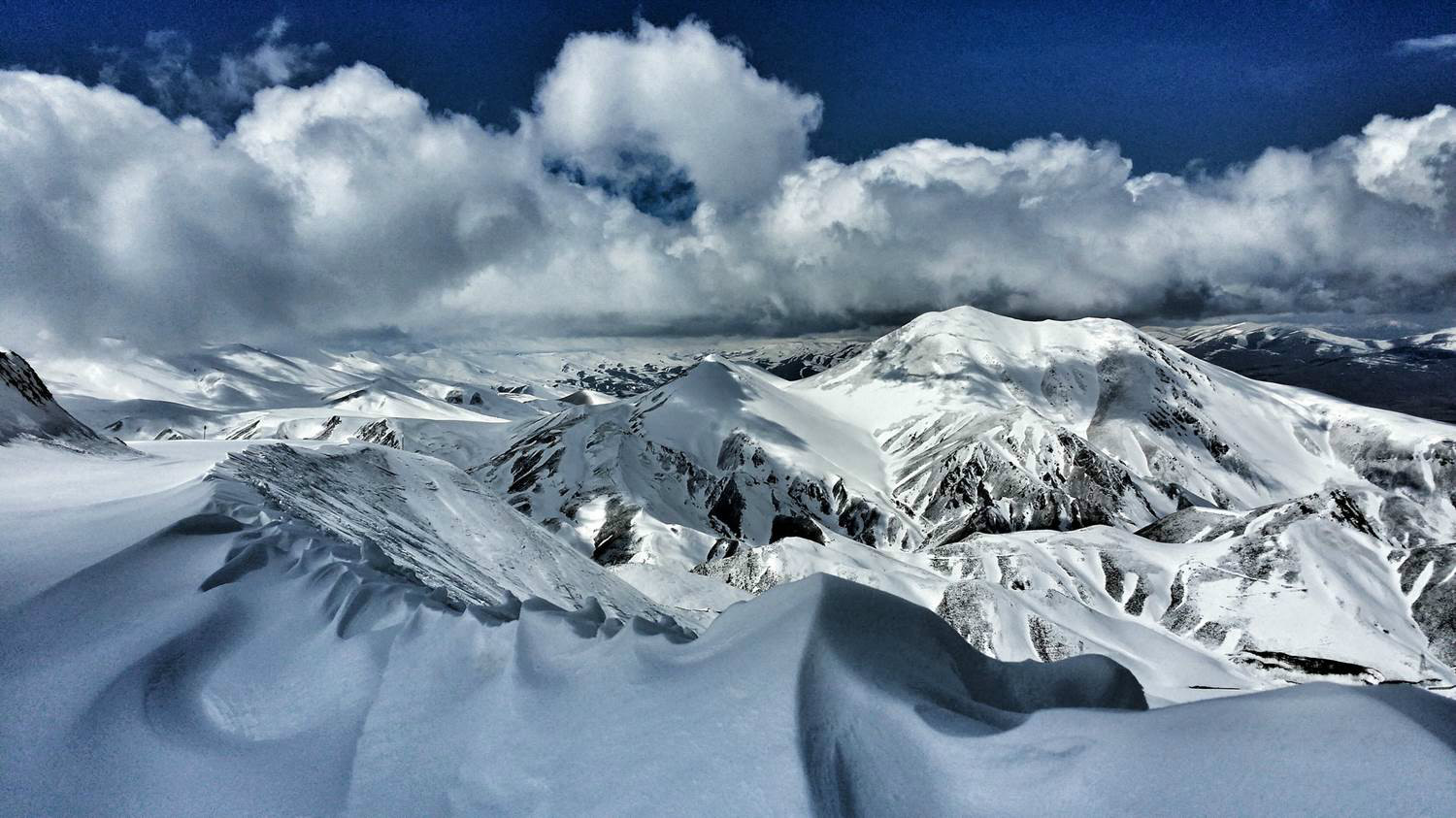
History of Erzurum dates back to 4000 B.C. Findings from the excavasions carried out araund Karaz, pulur, Güzelova and Ss show that there are ancient sttlements around Erzurum and its surroundings. Erzurum lived through the periods of Hurrie, Urartian, Iskit, Med, Persian, Sasuanide, Roman, Arabs and Byzantium util the malazgirt war in 1071. The city came under uhe administration of Emir Saltuq after this war ended. It became the capital city of The Saltuqian Dynasty from then on, the Turkish sove reignity started. Theimprove ment of the city continued during Satuqid, Anatolian Saltuqs end Ilhans. The city was conquered by Yavuz Sultan Selim in 1514 during the Ottoman Empire and underwent a thorough reconstruction under tehe reign of Süleyman The Magnificent. Many architectural works of art were built during this period, the population of the setlers increased in the city, overflowing and making way for the foundation of new districts.

Palandöken mountain is about 2200-3176m altitute and covers the area which is on the south, north-east, south-west of the city. Mount Palandöken covers area of 72 km. in lenght and 25 km. in widht. Mt. Palandöken, whichis among the foremost and privileged ski-centers in point of winter tourism and winter sports in Turkey, has conveyed the features of the International main station for winter activites. With this feature, it consititutes the most significant part of the city tourism sector. The south ski run is 8km. long. The north ski run is devised for the advanced skiers. The highest point if Mt. Palandöken is Great Ejder, which is 3188m. high. It is posible to ski on Great Ejder (2200-3100 m) and posible to reach 3100 m by chair lift is 3237 m. long and can carry 360 people per hour. It is posible to ski with drawn sledgesby horses besides skiing. The available skiing part of Mt. Palandöken is, 6 km. away from the city center and is located on the strait of Erzurum. The facilities situated on Mt. Palandöken are 16km. from the airport.

No inscription can be found on the medresse about its construction It is one of the biggest medresses in Anatolia. Open court, fourupper halls and two storey medresses are thought to bi built in the Ilhanid period at the end of the 13th Century and beginning of the 14th Century. In the Ottoman period the building was used as an arsenal during the time of Murat the fourth, then later as a barracks. The court is in the dimensions of 26x10 m. and is surround by a porch. The room in the west of the entranceis a small mosque. The pupils rooms are located on either side of the court. The design of the downstairs is the same as the upstairs. The botanical decorations in the medrese are the best samples of stonework and decoration of the Anatolian Seljuk period. The figured panels, a part of the decoration have the traces of the Turkish beliefs of Middle Asia. Some Panels such as the double-headed eagle, life tree and dragons were left half completed. Glazed brick minaarets rising on either side of the crown door built up to the levels of the balcony surrounding the minarets exist and the top parts are demolished. The tomb next to the upper hall on the south side of the medresse is the biggest mouseleum of its age. There is a grave room downstairs. Marbel was used for the interior decoration of the tomb.
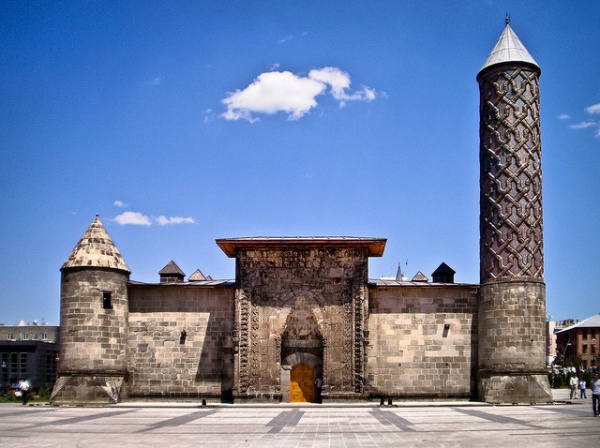
This structure was built by Cemaleddin Hodja Yakut on behalf of gazan Han And Bolugan Hatun in 1310 during the Ilhansid emperor period. Pupil rooms and classrooms are located on either side of the court. The surface of the room entrances have rosettas including different geometrical and botanical decorations. Tha panels that consist of eagle, life tree and lions motifs are located at both sides of the portal. There is a bricks decoration on the minaret body in the southwest corner. The tomb is next to the upper hall in the east. To day the Medresse is used as Turkish and Islamic Works andt Ethnographic museum where varios ethnographical objects of the region are exhibited.

The first construction date of the citadel is not known, but is thought to have been constructed by the byzantines in the first half of the 5th century A.D. The citadel is surrounded by an outer citadel on the hill it is located at. Today, the outer citadel, which hes a dual arrangement is ruined at a large scale and onlu the name remains of the doors which opened in four directions. These gates are Erzincan Gate, Tebriz Gate, Gürcü Gate, Istanbul Gate and New Gate founded later. There are eight towers on the walls of the Inner citadel. Its is posible to observe the restoration traces on the citadel walls at different periods. However, there are no inscriptions belonging to these periods.

The mosque exist next to the southern citadal walls, inside the citadel. The interior design of the mosque has a rectangular plan and is in two sactions parelel to the mihrab. It is covered with a dome with embroidered frames in front of the mihrab and with a cross-vault at the entrance. The eastern and western parts of both covers are widened with the vaults. Its Mihrab has a simply-decorated ornament placed in a semi-circular burch. The dome part of the mosque built with soft-rock stones is topped with a conical cover with a high vault outside. The mosque was built by the Saltuqs in the 12th century.

The Tepsi Minaret situated on the southwest corner of the citedal, was erected by the saltuquian Emirate Muzaffer Gazi in 1124-1132, according to the inscription under the gallery. It has a cylindirical shape built with bricks on a two colour-rock pedestal built up tu the level of the city walls. There are geomatric adornments on the upper part of the body. The Part over the gallery was desroyed. Later, in the 19th Century a galery with timber material in Baoroque styles was erected and a ball was installed. This is the ol des representative of minaret tradition in Anatolia erected during Karahanli and Great Seljuk periods.

These tombs are distinguished among the other Anatolian monumental tombs and four of these were built in this site. Of these three tombs, one is seated on an octagonal plan with a cover of tambour and conical roof is clamed to belong to Emir Saltuq. This monumental grave tomb built completely with hewn stone blocks belongs to the 12th. Century. Turkis-Chines calender animal carvings are ornamented in the niches under the tomb. The two other tombs which have not been identified are dated back to the 14th century.
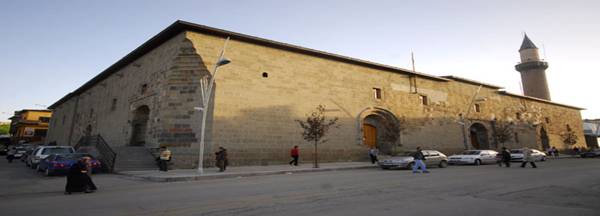
The Great Mosque is one of the ol dest in Erzurum. According to a currentl non present inscription, it was built by Nasuriddin Muhammed, a Saltuq Emir, in 1179 It is composed of seven platforms perpendicular to niche and has a size of 54x41 meters. The front part of the niche is covered with a timber dome. The middle platform has a wider and different covering There are plain geometric ornament on and around the niche. There are five gates, three of which are in the north and two in east. Built with cut stones, the mosque's minaret is seated on the north west corner and the mosque was restored in defferent periods.

The buildings in the city center was established as a kulliye. The palace and school buildings are ruined, but the mosque and the bath are functioning. The mosque was built by Lala Mustafa pasha, the governor of the city in 1562. It is accepted as a work of the architect Sinan. The building that was built without court is in the style of mosque with a central plan. The examples of this style are seen in Istanbul. Half and diagonal vaults are located in four corners. The minaret inthe north-west is short because of regional conditions. There are porcelain panels arounds the windows.

Murat Pasha Mosque was built in the period of Sultan Selim II in 1572 by the Emir Murat Pasha. It reflect the feature of classic Ottoman period with a sequared plan mosque.

The Habib Baba Tomb was built on behalf of Timurtas Baba in 1844 by Müsir Haci Kamil Pasha who was one of the commonders in Erzurum Formerly it was named as the Timurtas Tomb; Later is name was chaged to Habib Baba Tomb because he was the buried there after his death. He was the son of a mufti who was a sheikh of Kadiri. Habib Baba is also rememberd as earringed father since he wore earrings. His earrings hang at the peak of the colums of the tomb.

Erzurum is a city which is famous for its cold waters and fountains. A large number of fountains which are bred with water-springs that come from Palandöken mountains and Erzurum castle for the water necessity of the public. Most of the 179 fountains which have been determined in recent times belong to the period of the Ottoman and some have inscriptions. The Sabahane, Cennet, Gülahmet, Çeteci, Abdullah Pasha and Mehmet Kethüda fountains can be found among these.

Erzurum which is famous for its Kırkçeşme, Şeyler, Murat Paşa and Boyahane Bath are attractive. The bath culture has been kept alive by the people of Erzurum to date.

This structure was built by Tüstem Pasha The vizier of Suleiman the magnificient in the middle of the XVI century. The rooms are located around a square court and behind arched pillars. It has two floors. The upstairs consists of places in the shape of upper halls. Both two floors are used as shops where Oltu meer pieces are being manifactured. The other important inns in the region are Kamburoglu, Hacilar and Gümrük caravanseraies.

The old houses of Erzurum are mainly built with stone, soil wood and mine. There are three main types of stones used for the building of the houses; black stone, rey stone and kamper (red) stone. The corners and fronts of the buildings are built with archhewn stone and other parts with roung stone. Wood is secondarily besides the stones as material used for the building of old houses. Floor, ceiling, window, door, yüklük, seki, makat, stairs and hatil connecting the walls were alwasy made up from the wood. Tandirevi is also called with various names such as houses, cooking-house and kitchen in Erzurum. Having a peculiar architectural style, such as small oven, shelf, stone seat, store, fountain and kirlangiç cover, the tandirevi is used as a multi-functional place to cook, eat, rest and sleep. The old house of Erzurum has all the typical characteristics of a Turkish house, such as yüklük, gusülhane and sedir-makat in it's rooms and chamber rooms where men and women are not allowed together.

Cag kebab is a special kebab mostly cooked in Tortum, Oltu and Narman districts of Erzurum. It is a local type of Doner kebab called as Cag Kebap. It is made with slices of lamp threaded on a spit, with 10 percent minced beef mixed with milk, chopped onion, black pepper and flaked chili pepper spread between each slice to hold them together. The surface is covered tightly with wood ash and then the kebab is roasted horizontaly over a wood fire. As the outer surface browns, the cook takes a matal skewer and threads it through the coked surface, silices off the portion with along döner knife and serves it with thin lavas bread. It is a speciality dish of Erzurum.

Stuffed Kadayif is one of the tastes of The Erzurum kitchen. It is made by spreading a handful of the tel kadayif over the palm of the hand and placing a spoonful of chopped nuts in the center. It is then rolled neatly and then dipped into a bowl of beaten eggs and deep fried in a pan of hot oil. When golden brown, it is removed and set aside. When all the rolls are fried, a syrup made with 1 kg of sugar and 1.5 liters of water boiled for about 10 minutes until the consistency of then honey becomes thicker is prepared. The syrup is poured over the rolls and is served when it is cool.
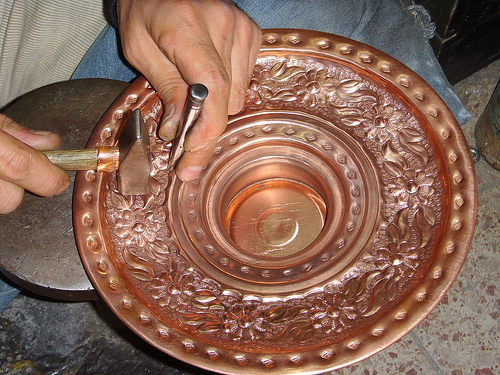
Handicrafts which had been rather alive until The 19th century mostly disappeared because of no keeping up with recent developments. Textile industry, coppersmithing and jewellery are those which remain alive today. Sellers and aba makers were those who here responsible for the clothes of the resdents of Erzurum. Those who made the wheels of the oxcard were called marancer. Weavers weaving sheet like the coverings made of wool and known as the local garment worn by women was another lost handicraft. Other handi crafts such as keçeciler, kevelciler, tandircilar, saraçlar, çakmakçilar, bıçakcılar, çikrikçilar, çarikçilar, hasircilar, blacksmith, sabuncular, were also lost as a result of the use of new techniques. Handicrafts which have been able to exist and survive and are jewellery, textile industry, pottery, even a few weavers. In this region, homespun woolen local garment, shawls, haircloth sack and tent have been woven The colors in the carpets woven in Erzurum are vivid and briliant. Jewellery, one of the most developed handicrafts in Erzurum, connotes its importance with ptominent silver pattern and bathstone, prayer beads, ring and necklace cigarette holder made of Oltu stone.

The Museum, in which the works were obtained from various places of Erzurum and neighbouring provinces exhibited was launched in the Double-Minaret Medrese in 1942 and it was moved to the present building in 1967. Excavations, B.C II. Thousand Trans-Caucas Culture, Urartu, The History of Nature and Armenian Massacres Salon are available in the museum. It has been used as Yakutiye Medresse, Turkish-Islamic Works and Ethnographic Museum since 1994.

This is one of Erzurum houses which were built in the last period of XIX century. It was used as a German Consulate for 9 months between 1915 and 1916. It was assigned to The Erzurum governship after the independence of Erzurum on The 12th of March 1918. After Mustafa Kemal Pasha landed in Samsun and came to Erzurum to hold congress, he stayed in this house with Hüseyin Rauf Bey and other friends for 52 days from 9th of July 1919 to the end of the congress. Mustafa Kemal Pasha executed congress work from house. After the decleration of the Turkish Republic, the golden key of the city and the title of the house was given to Mustafa Kemal Pasha, who came to Erzurum on 13 th of september 1924 by Nazif Bey, the Mayor.

Firstly, it was built in 1867 and was used as school. During The First World War it was set on fire and later The Erzurum Congress. Which began on 23 rd July 1919, was held here after it was repaired. The rebuilding of the buildin started in 1925 and was completed in 1928. The plan of the three-storey building is u shaped From the from this three-storey building looks like a two-storye from the font view because these are no windows to the front of the basement. It contains a neo classic style.

Bastions which were built for the defence of the city are the buildings of The XIX century. They were built with the purpose of perventing Russion attacks which were posible towards the city from the east are the areas in which 93 wars took place. All the 21 bastions were built with hewn stone. They do not have any decorations. These are buildings with big dimensions. Among these, big and small Palandöken Bastions were built at approximately 3000m. altitude.

The tomb belonging to Abdurrahman Gazi who was the descendant of the prophet Muhammed (a.s.) was built by Ayşe Hatun, the wife of Ziya pasha, the governer of Erzurum, in 1796. Inside the tomb, there is a 4.84 meter-length grave mde of local stone. His brother is also beside him. The mosque near the Abdurrahman Gazi tomb was built by the governer of Erzurum named Hadgi Ahmet İzzet Pasha in 1847 and was named after him. It is located at the outskirt of mount Palandöken on the south of the city and the area is used for picnic by the residents.

Waterfall at the end of the Lake Tortum are formed by a landslide blocking the riverbed. It is spectacular when the water is abundant in Spring Falls descending 48 meters over a rock. it offers the visitiorsa unique and gorgeous view and gives a great deam of delight to watch. It is 120 km. distant from Erzurum. The shores of the river and the vicinty of the lake are now being made into a national park.

This lake is formed by a land slide blocking the riverhead in Balikli village within Uzundere district in the mid of 1700. 120 km away from Erzurum. The fields that are covered with trees are used as resting areas in the peninsula towards the lake, also in Balikli village and its surroundings.

Uzundere is in the Çamlıyamaç villag. To its inscription, its construction was started by Andernese III in 961 during the reign of Bagratl Dynasty and completed by Magistros Bagrat in 966. Its architect was a craftsman called Grigor of Ösk.

It is located in Bagbasi village within Tortum district. It consists of a large church and small chappels. It was built between 976-1001 by David III. of the Bagrats. The church has a mixed plan (cross and basillica) and was built with two different stones of different colors which gives the building its impressive decoration.
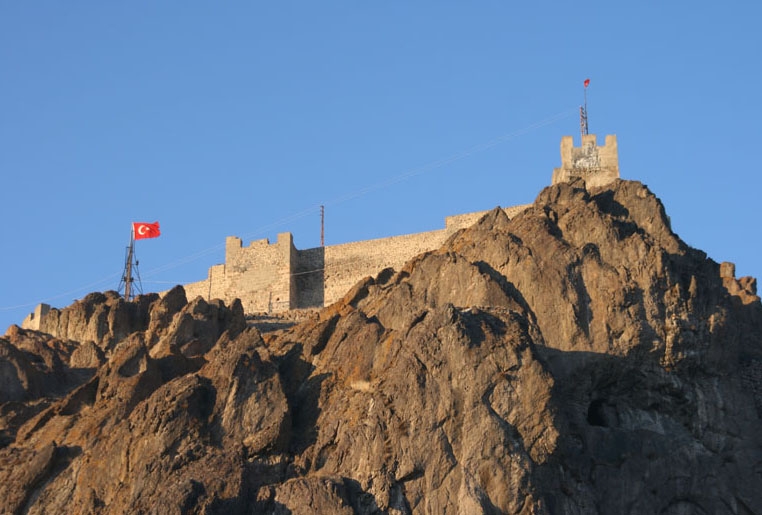
The castle is situated on the skirt of the mount Hasanbaba and rocks on the east of Pasinler. According to some sources, it was built by Hasan, the son of Emir Haci Togay. It is mostly ruined, however the south and west parts of the castle's interior are in good condition.

It is located on the north of Güzelhisar village in Köprülüköy. The castle which surrounded by three rampats has mostly features of Seljuks and Saltuqs architecture.
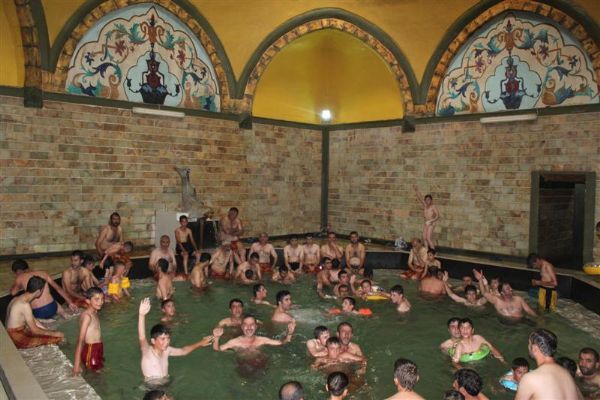
It is the town center of Pasinler and within the municipality frontiers. It is on the Erzurum-Iran international road. These thermal springs can offe service to 3702 people daily. It has a natural orign at 205 meters and has a flow value of 15 lt/sec.

Water springs have positive effect on the digestion system, kidney and urethan, he art diseases, blood circulation, defects of metabolism and rheumatism. Especially, those who have rheumatism and muscle diseases lie in mud so as to be cured.

It is a seven arched bridge constructed towards the end of the 13th century by vizier This bridge is where the Bingöl Stream and Hasankale Stream converge on the 58th kilometer of the Erzurum-Kars road. The bridge was built by Çoban Saltuz the vizier of Gazan Han, the Ilhanliemperor in 1927.

It is near the coruh river on the north-west of Ispir. The date of the building is unknown. It had been restored in the period of Saltuq, Seljuks and Ottoman Empire. The exterior rampart of the castle is ruined but the interior ramparts and bastions are in good condition.

Coruh river, the best river to do rafting, is 466 km and has the fastest flowing water than the other rivers in Erzurum. The world rafting competition was held in Coruh river in 1993 The starting point of this competitio was in Ispir. Coruh river and its environment has a view of natural beauties.

Elmali cave is situated in the mountain which is on the south-east of Elmali village that is on the road passing from Erzurum to Ispir. It is comprised of three caves It servers a wonderful place which is worth visiting with its lakes, stalactites, stalamites and bats.

The Yildizkaya cave, which is situated in the mountain, is on the north-east of Yildizkaya village in Olur. It is worth visiting with its stalactites, stalagmites and large galeries. The road which leads you to arrive in this cave has a wonderful nature and makes you evoke it forever.

This geological Formations are seen 7 Km. to the south of Narman. The wind and rain eroded the red sandy soil of the Land and rain eroded the red sandy soil of the Land and created a spectacular Landscape of red rock cones, capped pinnacles and fretted rawines, in colors of warm reds. Locals call these fascinating capped pinnacles "peribacalari" or "fair chimneys". These geological formation can be seen anly in Narman, in East Anatolia.

It was built next to Oltu stream and is located on a steep hill. The date of the building is unknown. The interior castle is in good condition and there is a very big and splendid bastion on the south of it. The rest of the castle is ruined.